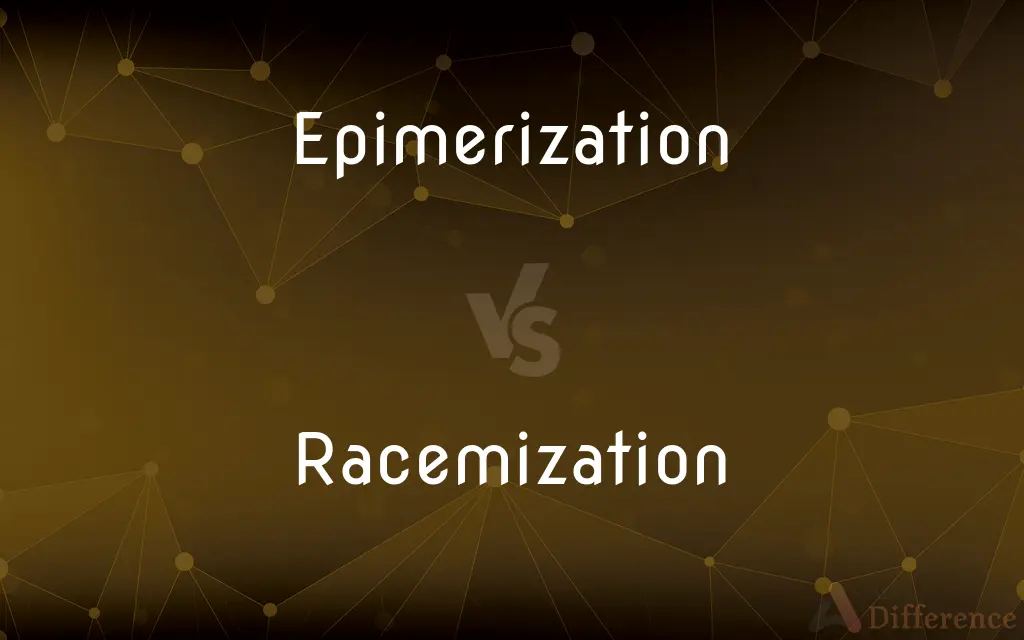Epimerization vs. Racemization — What's the Difference?
Edited by Tayyaba Rehman — By Maham Liaqat — Updated on March 15, 2024
Epimerization involves the inversion of stereochemistry at a single chiral center, while racemization refers to the process where a chiral molecule converts into a mixture containing equal amounts of its enantiomers.

Difference Between Epimerization and Racemization
Table of Contents
ADVERTISEMENT
Key Differences
Epimerization is a specific type of stereochemical alteration where only one chiral center in a compound changes its configuration, resulting in a diastereomer. This process is crucial in biochemistry, particularly in the transformation of sugars, where subtle changes in stereochemistry can lead to significant differences in biological activity. On the other hand, racemization is a broader process where a chiral compound transforms into an equimolar mixture of enantiomers, often leading to a loss of optical activity.
While epimerization affects only one chiral center and results in a compound that is still optically active, racemization involves the conversion of an optically active compound into a racemic mixture, which is optically inactive. This distinction is important in stereochemistry and is often exploited in organic synthesis and the manufacture of pharmaceuticals, where the specific configuration of molecules can have profound effects on their properties and activities.
Epimerization can occur under mild conditions and is often enzyme-catalyzed in biological systems, leading to highly controlled and specific reactions. In contrast, racemization usually requires harsher conditions or strong catalysts and is less specific, affecting all chiral centers in a molecule. This difference in specificity has significant implications for the synthesis and modification of chiral compounds in chemistry and biochemistry.
The rate of epimerization and racemization can vary greatly depending on the structure of the compound and the conditions under which the reaction occurs. Epimerization is typically a more selective and slower process, whereas racemization can proceed more rapidly, especially under conditions that promote the breaking and reforming of bonds at chiral centers.
Comparison Chart
Definition
Inversion at one chiral center, forming diastereomers.
Conversion to an equal mixture of enantiomers.
ADVERTISEMENT
Optical Activity
Results in optically active compounds.
Leads to optically inactive mixtures.
Specificity
Affects only one chiral center.
Affects all chiral centers in a molecule.
Conditions
Often enzyme-catalyzed, requires milder conditions.
Usually requires harsh conditions or catalysts.
Rate
Typically slower and more selective.
Can be rapid and less selective.
Compare with Definitions
Epimerization
Maintains optical activity, altering only the spatial arrangement.
In amino acid transformations.
Racemization
Formation of a 50:50 mixture of enantiomers.
In the degradation of amino acids.
Epimerization
Crucial in the modification of biomolecules.
In the metabolism of carbohydrates.
Racemization
Results in a racemic mixture that is optically inactive.
In the racemization of lactic acid.
Epimerization
Often enzyme-catalyzed, requiring specific conditions.
In the synthesis of complex natural products.
Racemization
Racemic mixtures can be more stable than pure enantiomers.
In pharmaceutical compounds.
Epimerization
Change in stereochemistry at one chiral center.
Glucose to mannose.
Racemization
Can occur under various conditions, including heat and catalysis.
During the aging of wine.
Epimerization
Occurs specifically at one chiral center.
In the epimerization of nucleosides.
Racemization
Used in the preparation of racemic mixtures for further resolution.
In drug synthesis.
Epimerization
(chemistry) The process of forming an epimer by changing one asymmetric centre in a compound that has more than one
Racemization
In chemistry, racemization is a conversion, by heat or by chemical reaction, of an optically active compound into a racemic (optically inactive) form. Half of the optically active substance becomes its mirror image (enantiomer) referred as racemic mixtures (i.e.
Racemization
Conversion of an optically active substance to a racemic form.
Racemization
(chemistry) The formation of a racemate from a pure enantiomer.
Common Curiosities
What is epimerization?
Epimerization is the process where one chiral center in a compound changes its configuration, leading to a diastereomer.
How does epimerization differ from racemization?
Epimerization alters one chiral center, maintaining optical activity, while racemization affects all chiral centers, leading to optical inactivity.
What conditions promote epimerization?
Epimerization often occurs under mild, specific conditions, frequently enzyme-catalyzed in biological systems.
What is racemization?
Racemization is the conversion of a chiral molecule into an equimolar mixture of its enantiomers.
What conditions lead to racemization?
Racemization can occur under various conditions, often requiring heat, chemical reactions, or catalysts.
Can epimerization be reversed?
Yes, epimerization can be reversible, especially in enzymatic reactions where equilibrium can be established.
How do enzymes influence epimerization?
Enzymes can catalyze epimerization, providing specificity and control over the process in biological systems.
How is racemization used in organic synthesis?
Racemization is used to prepare racemic mixtures, which can then be resolved into individual enantiomers for specific applications.
How does racemization affect pharmaceuticals?
Racemization can change the therapeutic properties of drugs, as the racemic mixture may have different effects compared to pure enantiomers.
What is the significance of optical activity in epimerization?
Optical activity in epimerization indicates the specific spatial arrangement of atoms, crucial for the biological function of molecules.
Why is epimerization important in biochemistry?
Epimerization plays a crucial role in the transformation and function of biomolecules, such as sugars and amino acids.
Is racemization a reversible process?
Racemization can be reversible under certain conditions, allowing for the interconversion between enantiomers.
What are the challenges associated with controlling epimerization and racemization?
Controlling these processes requires understanding the specific conditions that favor each reaction, which can be complex due to the subtle differences in molecular structures.
How does racemization affect the stability of compounds?
Racemization can lead to more stable racemic mixtures, which might be preferred in certain chemical and pharmaceutical applications.
What role does epimerization play in metabolism?
Epimerization is involved in the metabolism of various biomolecules, facilitating the conversion and utilization of nutrients.
Share Your Discovery

Previous Comparison
Whizz vs. Whiz
Next Comparison
Construction vs. ArchitectureAuthor Spotlight
Written by
Maham LiaqatEdited by
Tayyaba RehmanTayyaba Rehman is a distinguished writer, currently serving as a primary contributor to askdifference.com. As a researcher in semantics and etymology, Tayyaba's passion for the complexity of languages and their distinctions has found a perfect home on the platform. Tayyaba delves into the intricacies of language, distinguishing between commonly confused words and phrases, thereby providing clarity for readers worldwide.













































